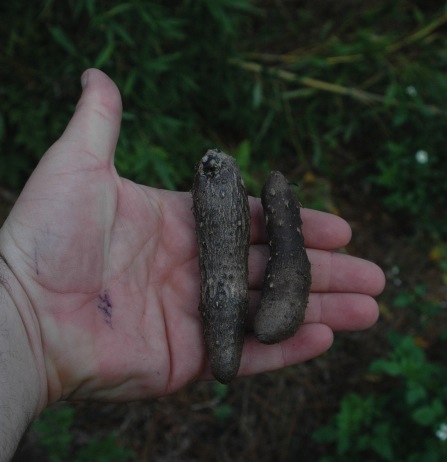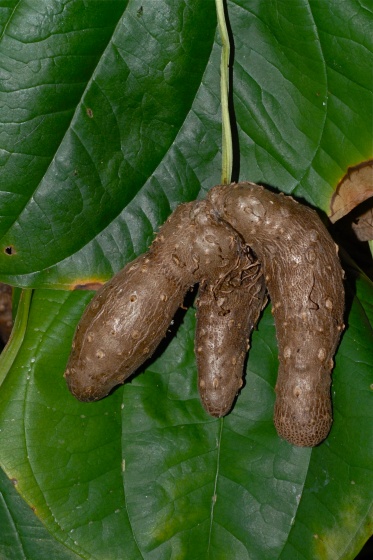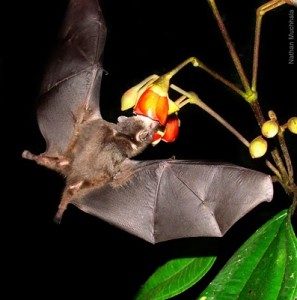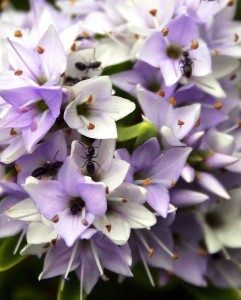Now is the easiest time to find our local major staple, the Winged Yam. Within three weeks the vines will die back for about 90 days. In some more northern areas they are yellowing already. But what you can still see are the indicator “air potatoes.”
In both classes this weekend the dark misshapen “air potatoes” of the Dioscorea alata were quite easy to spot hanging on the vine. They are long, or lumpy, or shaped like an L or a Y. They are not round, they are not tan. When you do see the kind of “air potato” pictured above or right carefully follow its square vine back to the ground. There, just below the surface, you will find a root weighing from a few pounds to more than 100. Cook it just like a potato though boiling is preferred. We don’t eat the “air potatoes.” We use them this time of year to easily find the vine. It is the root we eat. To read more about the Winged Yam click here.
Also spotted in Jacksonville, as it is a little cooler there, is Swinecress one of our little mustards that pop up during our winter. Bittercress was also growing, predictably near a drain spout. And the one patch of chickweed has survived mulching. It is also time for me to start checking in regular haunts for stinging nettles, found locally only during the winter.
Birds do it, bees do it even educated fleas do it, or so song-writer Cole Porter penned in 1928. In reality ants do it, too, and bats: They pollinate plants. When ants pollinate a plant it is called Myrmecophily. When bats do it that’s chiropterophily. Myrmecophily (mer-MEK-crow-filly) is from the Greek “myrmos” (ant) and “philos” (to love). Chiropterophily (chi-rop-tear-oh-FILL-ly, chi rhymes with eye) is also Greek for cheir, “hand” + pteron, “wing” and philos (to love.) Perhaps the best known plant pollinated by ants is Gorse. Bats pollinate the Kapok tree, bananas, mangoes and guavas. And without bats there would be no tequila as they also pollinate the Agave.
Many tropical flowers are night-blooming, which attract bats. Bat-flowers are usually white, cream, or pale green in color, making them easier to see in the dark. They have a musky, fruity or fermented odor and a large open shape so bat’s head and chest can get coated in pollen when it visits the blossom. Ants visit inconspicuous, low-growing flowers that grow close to the stem. Some plants use ants defensively to protect them from other insects by biting and stinging. Ant-pollinated plants include Small’s Stonecrop, Alpine Nailwort, and Cascade Knotweed.
And since you are bound to ask the answer is Ornithophily (or-knee-THO-fah-lee) pollenation by birds. Hummers do it all the time.
Don’t forget about the Florida Herbal Conference this February 15-17 organized by Emily Ruff. You can get a discount by signing up early and by using the code EATTHEWEEDS. If you register by Dec. 15th and use EATTHEWEEDS that’s a 20% discount. At conferences you have access to high-quality information and teachers who are experienced at making it enjoyable and understandable. You also spend a few days around other similar-minded folks so you don’t have to explain yourself. You become the majority. For more information and to sign up go to: Florida Herbal Conference.
The Green Deane Forum reached a milestone of sorts — or is it millstone? The site recently went over 1,000 members with nearly 3,000 page views a day. There more than 1600 foraging-related topics and 11,000 posts. Whether you are a new forager or experienced, looking to get a plant identified or share a great recipe, it’s on the Green Deane Forum. And as it is Green Deane’s forum be also participate daily and you can ask El Dinos questions as well. Also in the works is a chat room. Just because it is winter you don’t have to stop learning or participating in foraging. Visit or post on the Green Deane Forum today!
David Spahr is a Maine-based mushroom expert with some great photos on the Internet via Facebook. His most recent book is Edible and Medicinal Mushrooms of New England and Eastern Canada. Over the last 40 years he has eaten more than 100 different species of mushrooms and has not been ill once. As one should expect David tells us never to eat a mushroom (or any plant) without being absolutely sure of the identification. And I am sure he would add as I will study mushrooms with a live person… (come to think of it, studying mushrooms with a dead person might be a sign you are in serious trouble….) Don’t just go on Internet information alone. Learning mushrooms is something you do in person. David also has two personal rules of his own that he never violates: Never eat any white mushroom with white gills. Never. Never eat Little Brown Mushrooms. Never. White mushrooms with white gills are among the most deadly if not the most deadly of mushrooms. Little Brown Mushrooms (LBM) kill more professors of mycology than any other. Why? Because there are so many LBM we don’t know about them all. We don’t know what qualities they have, how they differ, or if any of them were or are edible. There is also the fact that the majority of LBM aren’t even named let alone thoroughly described. Avoid them. David also draws the line at boiling mushrooms saying there are better mushrooms available that don’t require boiling.
That said here is a list of 80 edible mushrooms in Florida (and probably The South and some elsewhere) compiled from the lifetime experience of Professor James Kimbrough of north Florida: Agaricus abruptibulbous, Agaricus blazei, Agaricus haemorrhoidarius, Agaricus projectellus, Amanita jacksonii, Armillaria mellea, Armillaria tabescens, Boletellus ananas, Boletus aureissimus, Boletus bicolor, Boletus edulis, Boletus granulosiceps, Cantharellus cibarius, Cantharellus cinnabarinus, Cantharellus coccolobae, Cantharellus confluens, Cantharellus lateritius, Cantharellus minor, Cantharellus odoratus, Clitocybe gibba, Collybia dryophila, Collybia iocephala, Coprinus comatus, Coprinus micaceus, Craterellus fallax, Gyrodon merulioides, Gyroporus castaneus, Gyroporus subalbellus, Hygrophorus coccineus, Laccaria laccata, Lactarius corrugis, Lactarius gerardii, Lactarius hygrophoroides, Lactarius indigo, Lactarius luteolus, Lactarius volemus var. volemus, Lactarius volemus var. flavus, Leccinum albellum, Leccinum albellum f. reticulatum, Leccinum chalybaeum, Leccinum rugosiceps, Leccinum subglabripes, Lentinula boryana, Lentinula edodes, Lentinus lepideus, Lepista nuda, Leucoagaricus americanus, Leucoagaricus brunnescens, Macrocybe titans, Macrolepiota procera, Macrolepiota rhacodes, Macrolepiota subrhacodes, Melanoleuca alboflavida, Naematoloma capnoides, Phylloporus boletinoides, Phylloporus foliiporus, Phylloporus rhodoxanthus ssp. americanus, Pleurotus djamor, Pleurotus ostreatus, Pluteus cervinus, Pluteus floridanus, Pluteus harrisii, Pluteus pellitus, Russula compacta, Russula grisea, Russula heterophylla, Russula mariae, Russula roseipes, Russula virescens, Strobilomyces confusus, Strobilomyces floccopus, Suillus cothurnatus var. cothurnatus, Suillus granulatus, Suillus hirtellus ssp. thermophilus, Tricholoma terreum, Tylopilus alboater, Tylopilus tabacinus var. tabacinus, Tylopilus tabacinus var. amarus, Volvariella bombycina, Xerula radicata.
One would think this happened in Florida but it occurred in Olympia Washington, the northwest U.S., near Canada. Detectives responding to reports of a shooting at a home in Washington state found a floor-to-ceiling stripper pole, 15 marijuana plants and two angry, five-foot alligators guarding them. A resident of the house, 41-year-old Darren Shore, left, was arrested on suspicion of attempted murder after telling detectives he had fired at a car on his property in self-defense out of fear it would run him down. The driver of that car had minor injuries. Before being taken away, Shore offered to help the detectives secure the hissing alligators. The three of them lured the reptiles into a bathroom with raw chicken parts. The alligators, which Shore owns legally, were left with a bathtub full of water and the chicken for food. Editor’s note: Alligators are edible. Taste like swampy chicken. An herb crust of marijuana improves the flavor dramatically.
Lastly this has nothing to do with plants but there is an English last name spelled Featherstonehaugh, sometimes Featherstonhaugh. One would think it would be said “Feather Stone Haw” or “Feather Stone Hoe” perhaps “Feather Stin Haw.” But no… and I thought the French were the specialists in unsaid lettering. How is Featherstonehaugh said? FAN-shaw… no, I have no idea why. It is said to be the longest surname in England. It’s pre-7th century Olde English when it was ‘feberstan’ which describes an ancient grave of three upright stones and a headstone. Perhaps one of my British readers will enlighten us. Any wild edibles in Northumberland? (There is also a Northumberland in New Hampshire as well.)
To donate to the Green Deane Newsletter click here.












Great Newsletter this is my first one. I am not a fan of pot with my Alligator I like it deep fried with some cocktail sauce. lol
I understand it is not legal for alligators to use pot in Colorado and Washington.
Interesting information on bats as pollinators. I had always thought that the night-blooming, light colored and highly scented flowers were moth pollinated. I’ve seen some fantastic looking moths near night-blooming flowers before. Wonder what the term is for moth pollination?
Pollination by moth? I’ll put it in the next newsletter.
Thank you for another interesting and informative newsletter. I especially appreciate your educating us about mushrooms. I read not long ago of some people here in California who were sickened when eating mushrooms they found in the wild.
Thanks. However, remember mushrooms must be learned in person, not off the internet.
There was a horrible tragedy in Loomis, CA, recently when a cargiver accidentally mistook some death caps for edible mushrooms and served them up in some soup at an elder care facility, resulting in several deaths. Deane, I sure am glad you stress positively, absolutely identifying your “assumed edible” before you eat it. There are lots of good, tasty mushrooms in the forests here, but you REALLY have to be careful not to confuse them with the bad ones.
lots of wild edibles in Northumberland…one of the most beautiful counties in England…see here for foraging courses:
http://www.tastethewild.co.uk/index.html
thanks for another informative and entertaining newsletter!
brian
..back again..
You can see a picture of one of these graves – known as the “Three Kings” here:
http://www.geolocation.ws/v/W/File:The%20Three%20Kings,%20Redesdale%20Forest%20-%20geograph.org.uk%20-%20582342.jpg/-/en
(what a horribly long URL)
These tombs (from the bronze age, dating from about 4000-3500 years ago), originally had 4 standing stones and are known locally as “four posters”.
Brian
Thanks… one never knows what one will find when one goes foraging.
So is it called anthrophily when I hand pollinate my feijoas?
Lets guess that moth pollination is somthing like lepidopterophily. Or, maybe I have it confused with butterfly pollination….. I’ll be interested in the answer.
Deane: does pot still grow in the wild or only under cultivation?
It’s naturalized in some areas.
Sir , I may tell of a plant , though not belonging to the same family of the Winged yam, yet has a tuberous edible root and a useful staple diet too . Recently I got familiar with ” Cassava ” tree ( Manihot esculenta ) which has been introduced to our garden by beloved “Nadia ” , my wife , who was so fond of the colorful compund leaves ( yellow ammid green in each leaflet with a pink midrib ) that she promised to make the plant available freely to transplant throughout all neighbours’ gardens for ornamental purposes . Under such ” subtropical climate ” ( Khartoum/Sudan ) and into the clay soil of the Nile a cassava twig grows buds within about four days if well watered . So famous for distributing twigs of Cassava branches that they used to call her by the new name ” Nadia Cassava ” . Being a staple diet in the tropics and subtropics , cassava flour of the tuberous root is used to make breads , tapioca ( local pudding ) , and some sort of beaverage . It is also used as a laundry starch . Oh how generous our earth is ! Truly it’s our duty to preserve it as healthy as possible .
This time I avail myself the opportunity to enquire about another tuberous plant ( I did eat the root when I was a child ) now a nuisance as I see it is invasive and I cannot get rid of it from my pitch ( 10×7 sq. meters ) of Uganda grass C. dactylon . The ” invador ” is nut grass or , if I am correct , Cyprus rotundus . Please tell me of an easy method to remove it completely and permanently . Thank you .
Unfortunately the only way I know of how to remove it is eating it.
I have night blooming cereus…
It was supernatural reveal when it dawned on me that these were BAT FLOWERS!!!
so great to confirm this magic here◇
Cheers